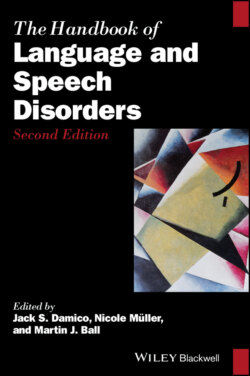Читать книгу The Handbook of Language and Speech Disorders - Группа авторов - Страница 15
1.1 Introduction
ОглавлениеAs a discipline oriented to communication, learning and social action, speech‐language pathologists are increasingly cognizant of the fact that our discipline stands with several other disciplines as firmly located within the social sciences. While we must acknowledge our debts to psychology, education, and medicine, our theoretical orientation over the past 30 years has been influenced by linguistics, sociology, and anthropology. In parallel with the other social sciences, our research methodologies and our clinical practices are progressively increasing our focus on naturalistic inquiry, authentic social contexts, interpretive and interactional perspectives, and the qualitative research paradigm (Duchan, 2010; Goodwin, 2014). This increased turn to the social sciences holds many advantages for our discipline. One of these advantages is how we can adopt aspects of social action theory to understand the complex process of labeling.
The term labeling within the human and social sciences refers to the tendency of providing an appraisal and/or a descriptor of others based upon any deviation from the perceived norm that is sufficient to garner attention (Matsueda, 2014); the typical outcome of labeling is some sort of categorization that creates differentiation. Social scientists have recognized that this process is ubiquitous in society. We are constantly observing and appraising others from our normative and interpretive perspectives. We note features of an individual’s appearance and behavior, and if even a subtle deviation from the perceived norm is identified, we have a propensity to create and use a label as mental shorthand. For example, if someone is observed as experiencing a brief unintelligibility while they are conversing, they may be labeled as exhibiting a communication deficit. Whether this label is accurate or appropriate is beside the point; it is sufficient to recognize that based upon some perceived deviation, there is a tendency to assign a label.
While this tendency toward labeling is common across all social actors, as professionals we formalize this tendency and treat it as a specialized circumstance referred to as “diagnosis” and, as sociologist Howard Becker (1963) has suggested, in such circumstances the label has power to create positive and negative consequences. As a result, care must be taken when assigning labels to others, whether we are in commonplace circumstances or within our professional venues (Conrad, 2007). To understand the impact of labeling and how it functions, this chapter will briefly discuss the social theory behind labeling; describe the role of labeling within the formalized diagnostic process, including some of the mechanisms employed to help establish the practice of assigning diagnostic labels for various perceived deviations; and detail some of the consequences of labeling via diagnostic categories in speech‐language pathology.
